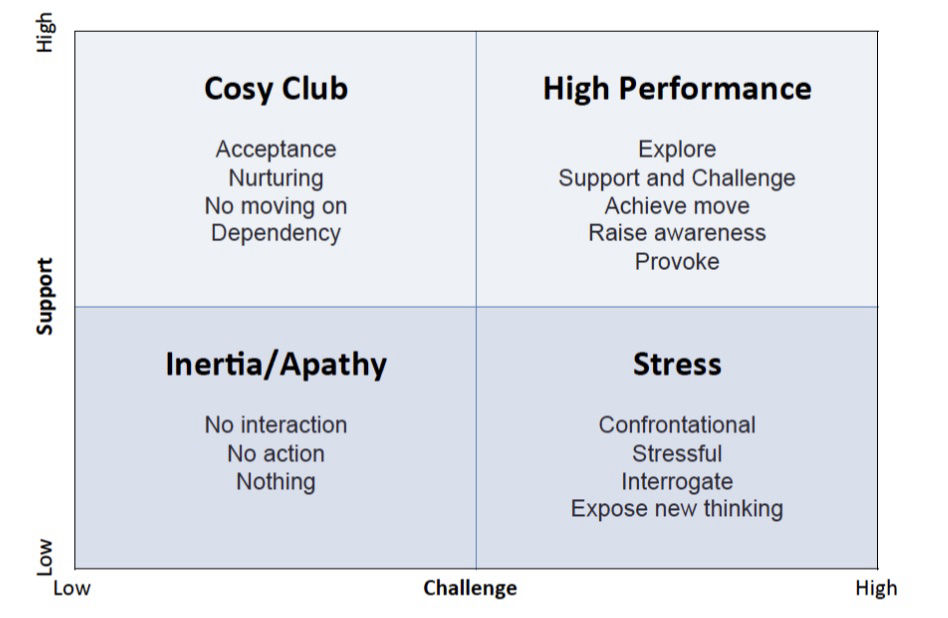
When describing what to expect from coaching to a client, I often use the support/challenge matrix (below) to help the client visualise the relationship between supporting and challenging them to explore their coaching topic more deeply.

The model shows that only when the client feels a high level of support, as well as a high level of challenge, can "High Performance" coaching be achieved. The other three areas are sub-optimal because the client is insufficiently supported or challenged, or both, for an effective coaching relationship to exist.
So, how does the coach go about making the client feel sufficiently supported to be comfortable with being appropriately challenged?
Assuming that coaching proceeds, the coach will then continue to build and evidence their support for the client. They can do this through:
The support continues to grow and develop throughout the coaching relationship, but it is not unusual for a client to feel sufficiently supported and be very open in their first session. It is the unusual nature of such a relationship, in which one party actively listens to the other in a confidential space, with the sole purpose of helping the other party achieve their goals, that often allows clients to trust their coach very early in the coaching relationship.
So, if that is how the coach supports the client, how does the coach appropriately challenge in the relationship?
The coach can start to explore and challenge in the chemistry session, in a light touch fashion, by encouraging the client to explore what they want to work on in coaching and then start to shape the coaching goals (some clients are very clear on what they want to work on from the start, others need more support to shape this).
The coach may ask questions such as:
This questioning approach starts to set the expectations of the coach as a partner who challenges the client to think more deeply about a topic, hopefully, in a fashion the client finds helpful and thought-provoking.
As the coaching relationship continues, the coach will continue to challenge the client through approaches such as:
It is worth bearing in mind that some people are far more comfortable with the challenge than others and so it is important that the coach checks with the client how comfortable they are with challenge and make it clear that the client can ask to dial up or down the level of challenge that works for them. This is further evidence of support from the coach to the client, as in "It’s your coaching, tell me what works/doesn’t work for you".
There is lots more that goes on in a client-coach relationship, but I hope exploring this support and challenge model has demonstrated how the trust and rapport necessary for "High Performance" coaching relationships can be built.
As I write this, I am reflecting on how much the client/coach relation is "in the moment" and very much about the "spoken word", so I hope I have done the topic justice above.
Please feel free to get in touch if you would like to have a chat about questions that this blog post has prompted for you.
From the author:
As coaching is not an advice-giving service, these blogs are not written with the intention of proposing solutions to common leadership challenges. Instead, they are thought pieces with the aim of prompting the reader to think more deeply about the topic and reflect on whether it warrants further exploration, with or without a coach.
If you would like to hear more about coaching and how to make it work for you, feel free to subscribe to my newsletter and to share this blog with anyone that might be interested in learning about executive coaching, how it works and whether it could be of benefit to them.